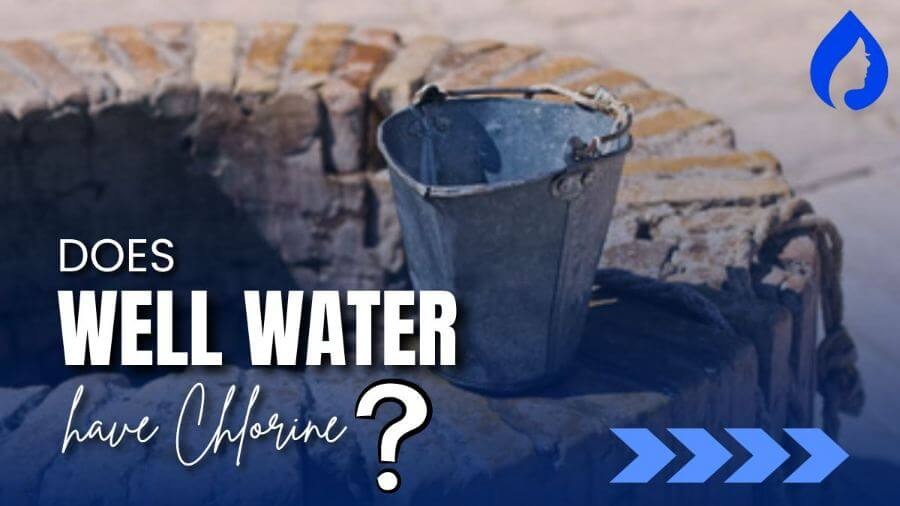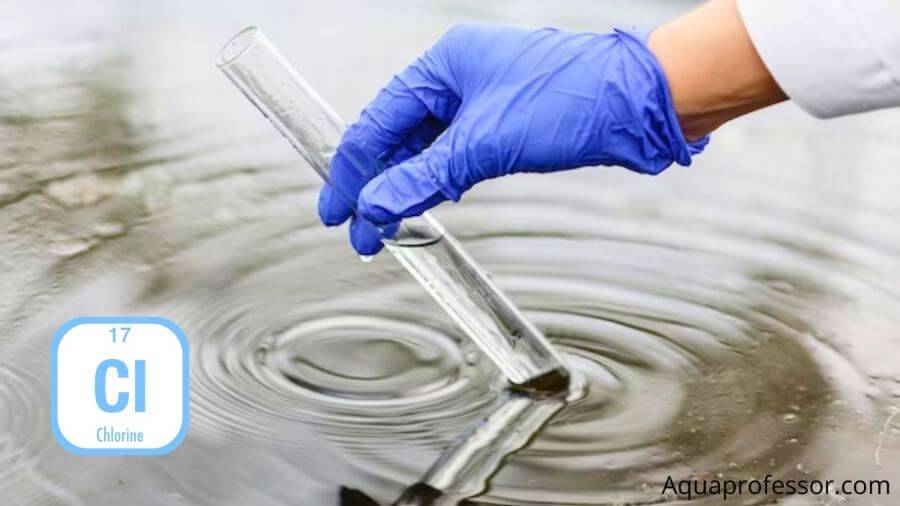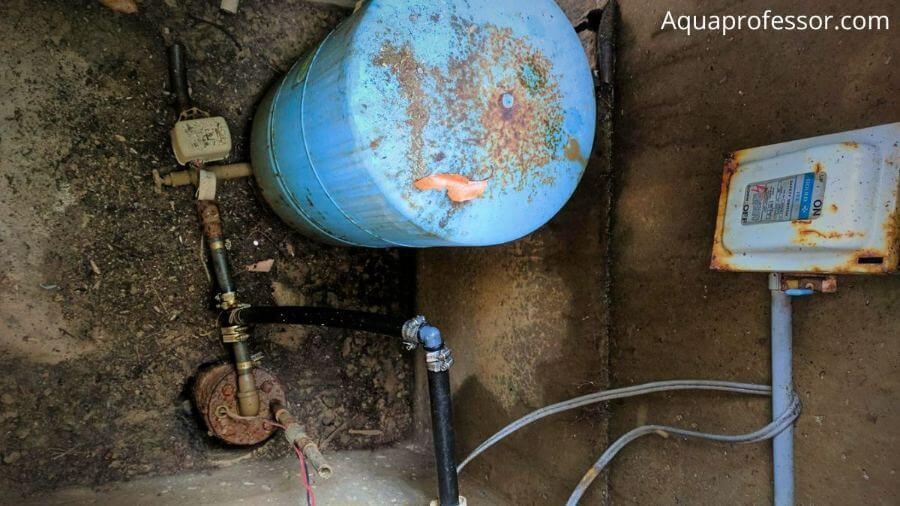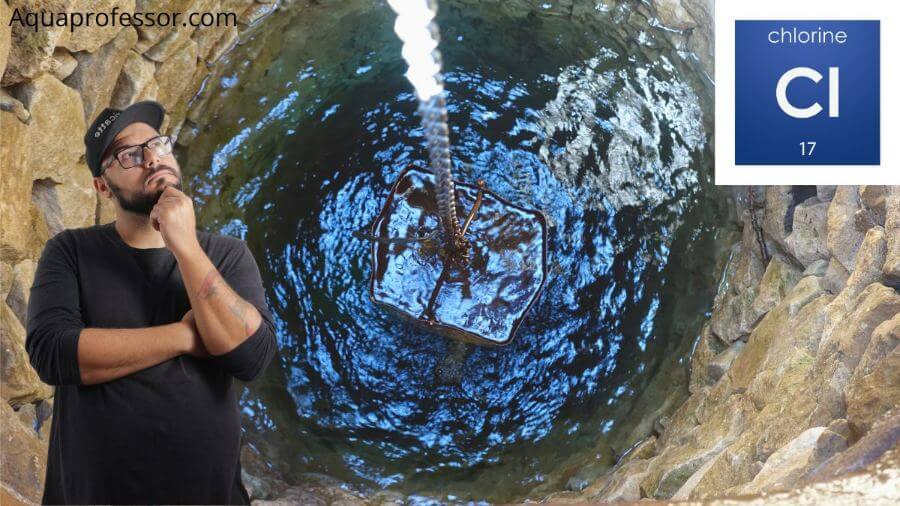
Did you find a weird bleach smell in your well water? Does your well water have chlorine?
No, chlorine doesn’t occur naturally in well water. Municipal authorities add it to public water for disinfection, but there’s no such addition in well water (unless you do shock chlorination).
Chlorine is heavily used in shock chlorination to control or clean bacteria (like coliform bacteria) from well water. So if you use water during the flushing period (30 minutes to 24 hours), you can get that weird chlorine odor.
Additionally, chloride occurs naturally in well water in small amounts from soil weathering and invasion of salty sea water in the water table.
Keep reading to learn how chlorine can be eliminated from well water easily.
🤔Is Chlorine Found in Well Water?

Chlorine doesn’t occur naturally in well water unless you add it via methods like shock chlorination.
Conversely, chloride occurs naturally in well water in small amounts and combines with calcium, sodium, or magnesium to form neutral salts.
Chloride may find its natural way back into well and drinking water supplies via:
EPA has set the safe aesthetic level of total chlorine (chlorine and related compounds) to 250 mg/L.
It gives off a salty taste, and chlorine smell, complicates pre-existing kidney diseases, and causes heart-related problems if present in higher concentrations.
Also Read: Why My Tap Water Smells Like Chlorine
⏲️How Long Does It Take To Get Chlorine Out of Well Water?

When you shock chlorinate your water system, it takes around 30 minutes to 24 hrs to circulate the chlorine solution in the whole system and to be removed from the well. The flushing period depends on the well’s size, well diameter, and depth.
While a deep well typically takes around 24 hours to complete, a shallow well could take as little as 30 minutes to flush out the chlorinated water until you no longer smell chlorine.
Shock chlorination: A quick explainer:
Shock chlorination is a well disinfection method where chlorine bleach with solid calcium hypochlorite and sodium hypochlorite solution is dumped into the well water. Chlorine should have enough contact time to kill E. coli or coliform bacteria and protect you from fatal bacterial infection.
This chlorination method is still the best and most cost-effective way to disinfect well water. Shock chlorination treatment should be done once every three to five years or whenever you find slime and odor.
However, if not done properly, shock chlorination can invite new problems than solving existing ones.
Chlorine comes in contact with living organisms and kills harmful bacteria. Excess chlorine reacts with other metals, dead tissue, animal and plant residues, or inorganic chemicals (bromide and chloride), forming disinfection byproducts (DBP) like chlorite, bromate, and trihalomethane.
These DBPs can be harmful if they enter your faucet water as they affect your nervous system and even increase cancer risk.
Hence, it is always advised to flush out the residual chlorine and other toxic chemicals from the well water system after the shock chlorination process.
In addition, wells and water supply should be tested with a total chlorine test kit after shock chlorination to check whether it has a high chlorine concentration.
Also Read: Does Well Water Have Fluoride?
👇How Do I Lower the Chloride in My Well Water?

Based on aesthetic concerns, EPA limits 250 mg/L as an acceptable chlorine level in well water systems.
You can test chloride levels in your well water using a certified lab. After checking the test results of chlorine concentration, you need to install a proper continuous disinfection treatment system to reduce or maintain the optimum level, like:
However, RO is preferred among several methods based on chloride concentrations (high concentration-POE).
Boiling the well water can kill the bacteria and also remove chlorine, but it’s not a foolproof method as:
Besides causing heart issues and kidney complications, high sodium and chloride make water corrosive, leading to leaching pipes. In addition, it can increase lead and copper concentration in water, so you can also test for lead and copper and install RO units that eliminate them effectively.
💡Does Well Water Have Chlorine In It: FAQs
Should well water be chlorinated?
Water chlorination should be done when you:
1. Dig a new well
2. Find slime and odor (indicating iron or sulfur bacteria)
3. Repair an unused well or after fixing a crack in a well casing or lid
4. Iron bacteria or sulfur-reducing bacteria (like slime and odor)
5. Well water turns murky or foggy after thunder or storm.
Does well water have fluoride?
Well water contains fluoride, occurring naturally from 0.1 ppm to 12 ppm. The fluoride concentration in well water depends on the location of your well, the presence of fluoride-bearing minerals, and the nature of the rocks near the well.
What minerals do you get from well water?
Well water has many minerals, including calcium, magnesium, zinc, iron, and manganese. These minerals have potential health benefits and provide all essential minerals to the body for proper functioning.
Which is healthier, well water or city water?
Both well and city water offer health advantages. Municipal water is heavily regulated and disinfects all water at water treatment plants to remove harmful microbes (like E.coli or coliform bacteria) and eliminate odors and other contaminants. Likewise, well water naturally contains healthy minerals like calcium and magnesium.
However, water from municipal sources may have excess chlorine, which can damage skin and cause chlorine smell and bad-tasting water. Similarly, well water can have excess hard minerals and iron, damaging plumbing and making daily life difficult. Hence, it’s important to evaluate the water quality objectively, whether of the city or well, and opt for treatment options if needed.
What health issues can well water cause?
The harmful microbes in well water can cause diarrhea, hepatitis, and giardiasis, including symptoms of vomiting, headaches, cramps, and fever. Heavy metals like lead, arsenic, and selenium can cause liver, kidney, intestinal damage, and even cancer in extreme cases.
Hence, it’s important to perform periodic well water tests to find harmful contaminants in your well water and install adequate treatment units to keep your drinking water safe.
Adarsh is a Health & Nutrition Sciences graduate with expertise in environmental health. He is associated with ventures like Glacier Fresh Filter and Simpure Filter Systems. Through Aqua Professor, he intends to provide helpful information to every home to help them make smarter decisions.
